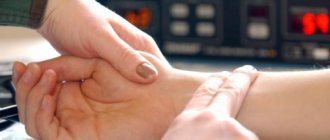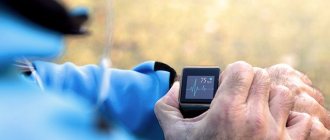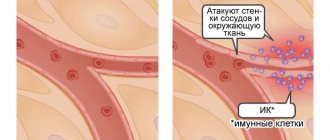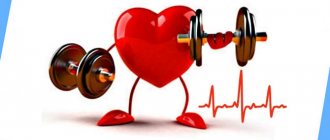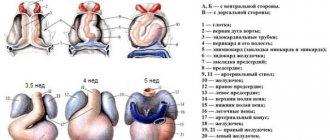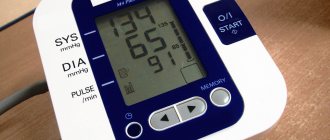Extrasystole (VC) is a form of cardiac arrhythmia characterized by untimely ventricular systoles. The conduction system of the heart is represented by the sinoatrial and atrioventricular nodes, bundles of His (consisting of 3 branches and a trunk) and Purkinje fibers. With this form of rhythm disturbance, it is difficult to conduct impulses along the Purkinje fibers and His bundles.
Main symptoms
According to statistics, an adult experiences about 30-40 “extra” heartbeats per hour. Below is the daily value for people with certain heart rhythm problems:
- from 720 to 960 additional impulses is the norm for people who do not have any problems with the cardiovascular system;
- from 960 to 1200 - the norm for those who have been diagnosed with “polymorphic extrasystoles” does not pose a threat to health;
- 1200 and above is no longer the norm and indicates the presence of problems with the heart rate, up to tachycardia.
Today, according to the results of the survey, 75% of people on the planet fall into the first two groups, and this does not at all indicate that this is fraught with any serious consequences for them. However, if extrasystoles are accompanied by severe clinical symptoms, it is not recommended to postpone going to the doctor. Among these symptoms, first of all, it is necessary to note:
- sensation of tremors in the chest in the region of the heart (occurs with vigorous contraction of the ventricles after a compensatory pause);
- interruptions and “fading” in the work of the heart, which are accompanied by lack of air, sweating, fever and weakness;
- in advanced cases: dizziness and faintness, which occurs due to a decrease in blood flow to the brain during moments of “shocks” and “fading” of the heart.
Norm of extrasystoles per day: what to do in case of rhythm disturbances
Additional education:
"Cardiology"
State educational institution "Institute for Advanced Medical Studies" of the Ministry of Health and Social Development of Chuvashia
Contacts
Such a phenomenon as extrasystoles significantly complicates the work of the heart muscle, causing its additional “unscheduled” contraction and stimulating more active wear and tear of the myocardium. Manifesting externally in an uneven rhythm of heart contractions, extrasystoles cause a feeling of lack of oxygen and interfere with the patient’s breathing.
The greatest manifestations of an increase in the number of extrasystoles are observed when receiving a load - physical and psychological; At rest, this phenomenon is usually not felt by the patient.
The average rate of exvarasystole per day may vary somewhat in different patients; much of this indicator depends on the state of health in general and the cardiac system in particular, the degree of load during the day and the person’s lifestyle.
Modern medicine provides data on the number of contractions of the heart muscle, which can be called the average statistical norm for a healthy person. Each case is individual, therefore there may be various deviations from the average figure.
To identify a condition such as extrasystole, you should pay attention to your own sensations, and if you suspect disruptions in the heart rhythm, contact a cardiologist for a full examination.
After all, extrasystoles, which often occur throughout the day, not only worsen the general well-being of the patient, but can also cause serious cardiac changes.
Possible consequences of frequent cardiac extrasystoles
With the frequent appearance of human-perceptible extrasystoles in the heart, the total volume of load placed on the heart muscle increases significantly.
This leads to an increase in the rate of wear of the myocardium, increasing the likelihood of developing serious consequences for overall health.
Cardiac diseases caused by frequent extrasystoles in the heart are accompanied by damage to the tissue of the heart muscle, deterioration of the myocardial process and the likelihood of having a negative impact on human health.
Extrasystoles occur when there is an increase in the rate of occurrence of electrical impulses that arise from the outside (usually due to psychological experiences and emotional overload) and affect the myocardium. The impact of such unscheduled extrasystoles on the sinoarterial node, which is less susceptible to such influences, is considered normal.
An extrasystole is essentially an empty, idle contraction of the heart muscle, which does not lead to the release of blood into the vessels of the heart. This is explained by insufficient filling of the heart with blood, when receiving an electrical impulse it contracts without pumping blood in the right direction.
In this case, muscle contraction is observed without the desired result.
One-time extrasystoles do not entail serious damage to the heart, however, if such a manifestation is repeated frequently, there is a high probability of pain in the heart, thinning of its tissues and a decrease in the conductivity of the electrical impulse.
Difference between types of extrasystoles
Depending on what type of this pathology has arisen in the body, its main symptoms may vary. The number of contractions of the heart muscle during the day is also in accordance with both the general state of human health and the type of cardiac lesion.
Today in medical practice there are two main types of extraordinary extrasystoles:
- Supraventricular extrasystoles are extrasystoles that occur when an electrical impulse is transmitted from any part or area of the atria of the heart muscle, but not from the sinus node.
- The ventricular variety of extrasystoles is characterized by their occurrence in any part of the ventricles of the heart.
There is also a special classification of such a phenomenon in the work of the heart muscle as extrasystoles, according to the number of consecutive ineffective contractions of the heart, during which the heart does not pump blood. This classification looks like this:
- single extrasystoles;
- paired, or couplets;
- group ones, which are felt to the greatest extent. Usually there are three (triplets) or four cardiac extrasystoles in a row.
The listed methods for classifying extrasystoles help make a preliminary diagnosis based on the examinations performed.
The most characteristic manifestations
Depending on the specific case, the indicator of extrasystoles may vary. Normally, a person who does not have significant problems with the cardiovascular system can experience about 30-40 “unscheduled” contractions of the heart muscle per day, which does not have pronounced negative consequences for the myocardium.
According to numerous studies, extrasystoles in the heart do not always lead to serious cardiac pathologies. There is a certain system of norms for this manifestation, which is recognized as the norm and does not pose a real danger to human health.
Norm and excess of norm in the manifestation of extrasystoles
Depending on the number of registered extrasystoles, a cardiologist can make a diagnosis of the presence or absence of cardiac pathology.
The number of daily contractions of the heart without pumping blood, which are essentially extrasystoles, for a completely healthy person is about 100 times.
An increase in this figure may already indicate the presence of cardiac pathology, which requires prompt therapeutic intervention to prevent harm to the body and the heart in particular.
To identify the presence of pathology, the doctor calculates the number of contractions per day. It is this figure that determines the presence or absence of cardiac pathology. Extrasystoles in the heart are formed due to the appearance of electrical impulses that are transmitted to the myocardial tissue and provoke ineffective contractions.
The number of extrasystoles may vary depending on whether a person has certain deviations from the norm in the state of the cardiovascular system as follows:
- additional electrical impulses in the amount of 650 to 960 can be called the average norm for a person who does not have serious health problems;
- impulses in the amount of 960-1150 are not a significant danger to health and are classified as “polymorphic extrasystoles”;
- with an increase in the number of electrical impulses affecting the myocardium, more than 1200, there is already a basis for concern and a danger to health arises. The most common consequence of this phenomenon is tachycardia, as well as disturbances in the frequency and rhythm of heart contractions.
Normally, it is considered to be about 580-850 impulses entering the cardiac muscle tissue: in this situation, there are no pronounced changes in the condition of the heart, the frequency of its contractions and the general well-being of the person. The first two groups of manifestations of electrical impulses listed above do not pose a health hazard, do not worsen a person’s general well-being, and therefore may not be considered hazardous to health.
However, if unpleasant subjective manifestations or increased heart rate occur, you need to consult a cardiologist who will check other health indicators and make a preliminary diagnosis.
The number of heartbeats per minute depends on the individual; According to medical statistics, almost 75-80% of the entire population of the Earth has a small number of “unscheduled” extrasystoles throughout the day, which does not have a pronounced negative impact on health.
Even in the initial stages of the onset of this pathology, preventive action should be started, which will prevent the main symptoms from passing into an advanced state.
It is the initial stages that are most amenable to complete cure.
Therefore, even minor manifestations of health problems and the appearance of the first symptoms should be a good reason to consult a doctor.
The most characteristic symptoms of extrasystoles
Using the characteristic manifestations of a condition such as extraordinary extrasystoles listed below, it is possible to promptly identify the initial stage of this cardiac lesion. The main symptoms of extrasystoles include:
- subjective sensations characterized by disturbances in the rhythm of heart contractions, a decrease in the amount of blood transported by the heart, which leads to insufficiency of air and inferior breathing;
- “fading” and disruptions in heart rhythm, in which many patients experience fever and sweating, as well as severe weakness;
- at later stages of the disease, many patients complain of dizziness and instability of self-awareness. These sensations arise due to insufficient blood flow to the tissues of the body due to interruptions in its contractile activity.
In a normal heart rate, the above manifestations are not felt. The occurrence of excessively frequent electrical impulses leads to a lack of oxygen in the consumed air, an increased level of fatigue and dizziness.
Forecasts for detected extrasystoles in the heart
According to the majority of modern cardiologists, both types of extrasystoles, when their frequency of manifestations is within the established norm, do not cause significant inconvenience to the patient and do not harm his health.
The therapeutic methods in this case do not bring significant positive changes, therefore, for stable and uninterrupted functioning of the heart muscle, it is enough to regularly conduct a complete examination of the entire cardiovascular system.
According to research, supraventricular extrasystole is the least likely to pose any health hazard. Its manifestations are less noticeable in everyday life and do not affect either the rhythm of heart contractions or the quality of blood pumping by the heart muscle.
Ventricular extrasystole also does not pose a significant danger to human health. However, if the indicators of extrasystoles per day exceed more than 3,000, a full examination of the cardiac system should be carried out: there is a possibility of heart failure and tachycardia, which already pose a danger to health, and in an advanced state - a danger to the patient’s life.
Source: https://CardioPlanet.ru/zabolevaniya/aritmiya/norma-ekstrasistol-v-sutki
Ventricular extrasystole
The most common heart rhythm disorder, characterized by interruptions in ventricular contractions. Research shows that it affects 50% of young people worldwide, and the chances of being at risk increase with age. Ventricular extrasystole is caused by the premature supply of electrical impulses from the His bundle and Purkinje fibers, which leads to “extra” contractions of the ventricles. It most often affects people who abuse alcohol and smoking. Another reason for the development of pathology can be stress. However, in medical practice there are also cases when the disease affects people leading a healthy lifestyle.
In 90% of cases, ventricular extrasystole is observed in patients who have suffered a myocardial infarction and suffer from coronary heart disease. Pericarditis, myocarditis and various forms of cardiomyopathies can also cause the development of the disease. In addition, the possibility of developing pathology due to long-term use of beta-agonists, antidepressants, antiarrhythmic drugs and diuretics cannot be excluded.
Treatment of ventricular extrasystole is applicable only to those individuals who have severe symptoms of the disease described above. Patients are usually prescribed sedatives (including tranquilizers) - Obzidan and Anaprilin. If treatment does not produce results, anticholinergic drugs are used: Belloid, Bellataminal, etc. Self-medication in this case is contraindicated: a course of therapy can only be prescribed by a cardiologist.
Supraventricular extrasystole
This disease is a fairly common type of arrhythmia, which is characterized by premature delivery of electrical impulses to the upper parts of the heart. Supraventricular extrasystole can begin to develop in a patient in adolescence for no apparent reason and, as a rule, affects people who are tall and thin. The causes of the development of pathology can be neurogenic, toxic and medicinal factors. Recent studies show that extrasystoles of this type make themselves felt at the first prerequisites for tachycardia.
As with ventricular extrasystoles, supraventricular extrasystoles can be caused by alcohol consumption, smoking and stress. Taking heart medications without consulting a doctor can also trigger the development of the disease. In some cases, the disease develops against the background of disturbances in the functioning of the pancreas.
You can get rid of supraventricular extrasystoles at the initial stage of the disease with the help of drug treatment. As a rule, drugs of the antiarrhythmic group, glycosides and drugs that normalize blood pressure are used. Almost all of them have side effects and therefore should be used only after examination under the supervision of a physician. In advanced cases, the possibility of surgical intervention cannot be ruled out, so you should contact a specialist immediately after the first symptoms appear.
Course of therapy
The treatment regimen must be comprehensive in order to quickly restore the normal functioning of the heart. Depending on the situation, this may include several effective methods:
- compliance with the rules of a healthy lifestyle;
- eliminating the root cause of heart failure;
- use of antiarrhythmic drugs;
- surgical intervention.
The course of treatment is supplemented with folk remedies and physiotherapeutic procedures. The help of a surgeon is usually required when other methods are ineffective.
Lifestyle correction
For a faster recovery and to prevent relapses, it is advisable to follow the following recommendations:
- avoid stressful situations and physical overload;
- exercise at a moderate pace;
- take breaks while working;
- sleep 8 hours a day;
- to refuse from bad habits;
- spend more time outdoors.
The correction will also affect the patient’s nutrition:
- exclude smoked, fatty and fried foods;
- reduce consumption of sweets, preserves and salt;
- eat up to 5-6 times a day (small portions);
- diversify your diet with vegetables and fruits;
- cook by boiling, baking and steaming;
- Take your last meal no later than 2-3 hours before bedtime.
Drug course of treatment
Antiarrhythmic drugs will help restore sinus rhythm and prevent new attacks of arrhythmia:
- Potassium channel blockers (Amiodarone, Cordarone) prevent the element from entering cardiomyocytes, thereby reducing their electrical activity.
- Medicines based on potassium and magnesium (Doppelherz Active, Asparkam) help restore electrolyte balance. Thanks to this effect, neuromuscular transmission improves and vascular tone is stabilized.
- Beta-adrenergic receptor blockers (Carvedilol, Acridilol) reduce the degree of adrenaline perception, which reduces heart rate, blood pressure and myocardial oxygen demand.
- Calcium antagonists (Diltiazem, Felodipine) block calcium channels, due to which it is possible to dilate blood vessels and stabilize the functioning of the heart.
Medicines, as well as their dosage and form, are selected by the attending physician. It is prohibited to change the treatment plan on your own. If adverse reactions develop, you must temporarily stop taking the medication and consult a specialist.
Surgery
If severe disruptions in hemodynamics due to a large number of extrasystoles cannot be eliminated with medication, then surgery is prescribed. Its essence is to remove foci of ectopic signals:
- Radiofrequency ablation is a minimally invasive intervention that allows cauterization of sources of false impulses by inserting a catheter through the femoral artery.
- Open heart surgery is prescribed when serious correction is necessary (excision of an aneurysm, replacement of valves).
- Installing a pacemaker or defibrator will help stop attacks of irregular heartbeat. Prescribed for the transition of extrasystole to atrial fibrillation or paroxysmal tachycardia.
A successful operation allows the heart to return to normal rhythm. The recovery period depends on the type of intervention.
Diagnostics
Extrasystoles of all types can be detected by a cardiologist during the process of palpating the pulse. However, to create a clear picture of the disease, a patient with suspected pathology must undergo an ECG diagnosis. The device will allow you to determine the source of extrasystoles and their type with 100% accuracy. Cardiac ultrasound and MRI can also be performed as additional diagnostic tools at the doctor’s initiative. Extrasystole appears on the electrocardiogram in the form of the following signs:
- decreasing the interval between the P wave of the main rhythm and the P wave of the additional impulse;
- decreasing the interval between the QRS complex of the main rhythm and the QRS complex of the additional impulse;
- obvious deformation and increased amplitude of the extrasystolic QRS complex;
- absence of a P wave before the ventricular extrasystole.
It is worth noting that the ECG in this case is performed using the Holter system. It follows that the patient must participate in the examination for 24 to 48 hours at a time without removing the measuring device. In addition, the patient must periodically change the level of his activity and record all his sensations and changes in well-being in a diary.
Classification
Extrasystole is divided according to many criteria:
| Name | Peculiarity |
| Location of the focus of ectopic (false) signals | • supraventricular – the source of replacement impulses is located in the atria and atrioventricular node; • ventricular – the source of false signals is located in the ventricular space. |
| Rhythm | • Single contraction (extrasystoles occur without a specific rhythm). • Allorhythmic extrasystole (contractions occur at regular intervals): o bigeminy – appear after contraction; o trigeminy – occur after 2 contractions; o quadrigeminy – appear after the 3rd contraction. |
| Number of layoffs (consecutive) | • single; • steam room; • group. |
| Number of sources of false signals | • monotopic (monomorphic) – extraordinary contractions are a consequence of replacing signals from one source; • polytopic (polymorphic) – extrasystoles arise due to several foci of ectopic impulses. |
| Frequency of occurrence of extraordinary contractions (per minute) | • rarely – up to 5; • average – up to 10; • often – over 10-15. |
Treatment methods
Before you begin treatment of the disease, you need to make sure that it is severe. Extrasystoles are often secondary to a more serious disease and can be eliminated in the process of eliminating it. For example, having cured thyrotoxicosis or coronary heart disease, the patient in most cases gets rid of arrhythmia. Practice shows that it is worth starting treatment for extrasystoles only if their number exceeds 700 per day. Otherwise, therapy can do much more harm to the patient than good.
The greatest effect in the treatment of extrasystoles is achieved when taking antiarrhythmic drugs (AAP). During the period when the patient undergoes a course of therapy using them, the number of heartbeats returns to normal. However, the presence of side effects with these drugs is extremely high and therefore their use is accompanied by the prescription of beta-blockers and Amiodarone. The patient must be prepared for the fact that specialists will not immediately be able to choose the right treatment method for him. Primary therapy is almost always carried out by trial and error, and in the first 3-4 days, doctors will only be busy looking for the best options for solving the problem. After determining the treatment method, the patient shows positive dynamics.


